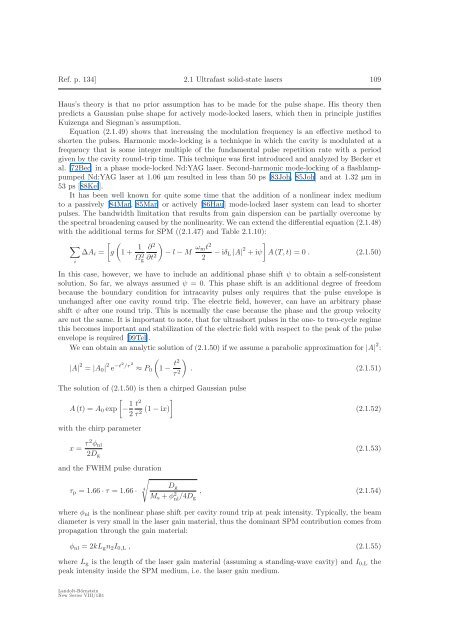2.1 Ultrafast solid-state lasers - ETH - the Keller Group
2.1 Ultrafast solid-state lasers - ETH - the Keller Group
2.1 Ultrafast solid-state lasers - ETH - the Keller Group
Create successful ePaper yourself
Turn your PDF publications into a flip-book with our unique Google optimized e-Paper software.
Ref. p. 134] <strong>2.1</strong> <strong>Ultrafast</strong> <strong>solid</strong>-<strong>state</strong> <strong>lasers</strong> 109<br />
Haus’s <strong>the</strong>ory is that no prior assumption has to be made for <strong>the</strong> pulse shape. His <strong>the</strong>ory <strong>the</strong>n<br />
predicts a Gaussian pulse shape for actively mode-locked <strong>lasers</strong>, which <strong>the</strong>n in principle justifies<br />
Kuizenga and Siegman’s assumption.<br />
Equation (<strong>2.1</strong>.49) shows that increasing <strong>the</strong> modulation frequency is an effective method to<br />
shorten <strong>the</strong> pulses. Harmonic mode-locking is a technique in which <strong>the</strong> cavity is modulated at a<br />
frequency that is some integer multiple of <strong>the</strong> fundamental pulse repetition rate with a period<br />
given by <strong>the</strong> cavity round-trip time. This technique was first introduced and analyzed by Becker et<br />
al. [72Bec] in a phase mode-locked Nd:YAG laser. Second-harmonic mode-locking of a flashlamppumped<br />
Nd:YAG laser at 1.06 μm resulted in less than 50 ps [83Joh, 85Joh] and at 1.32 μm in<br />
53 ps [88Kel].<br />
It has been well known for quite some time that <strong>the</strong> addition of a nonlinear index medium<br />
to a passively [84Mar, 85Mar] or actively [86Hau] mode-locked laser system can lead to shorter<br />
pulses. The bandwidth limitation that results from gain dispersion can be partially overcome by<br />
<strong>the</strong> spectral broadening caused by <strong>the</strong> nonlinearity. We can extend <strong>the</strong> differential equation (<strong>2.1</strong>.48)<br />
with <strong>the</strong> additional terms for SPM ((<strong>2.1</strong>.47) and Table <strong>2.1</strong>.10):<br />
∑<br />
ΔA i =<br />
i<br />
[<br />
g<br />
(<br />
1+ 1 Ω 2 g<br />
∂ 2 )<br />
∂t 2 − l − M ω mt 2<br />
− iδ L |A| 2 +iψ<br />
2<br />
]<br />
A (T,t)=0. (<strong>2.1</strong>.50)<br />
In this case, however, we have to include an additional phase shift ψ to obtain a self-consistent<br />
solution. So far, we always assumed ψ = 0. This phase shift is an additional degree of freedom<br />
because <strong>the</strong> boundary condition for intracavity pulses only requires that <strong>the</strong> pulse envelope is<br />
unchanged after one cavity round trip. The electric field, however, can have an arbitrary phase<br />
shift ψ after one round trip. This is normally <strong>the</strong> case because <strong>the</strong> phase and <strong>the</strong> group velocity<br />
are not <strong>the</strong> same. It is important to note, that for ultrashort pulses in <strong>the</strong> one- to two-cycle regime<br />
this becomes important and stabilization of <strong>the</strong> electric field with respect to <strong>the</strong> peak of <strong>the</strong> pulse<br />
envelope is required [99Tel].<br />
We can obtain an analytic solution of (<strong>2.1</strong>.50) if we assume a parabolic approximation for |A| 2 :<br />
( )<br />
|A| 2 = |A 0 | 2 e −t2 /τ 2 ≈ P 0 1 − t2<br />
τ 2 . (<strong>2.1</strong>.51)<br />
The solution of (<strong>2.1</strong>.50) is <strong>the</strong>n a chirped Gaussian pulse<br />
[<br />
A (t) =A 0 exp − 1 t 2 ]<br />
2 τ 2 (1 − ix)<br />
with <strong>the</strong> chirp parameter<br />
(<strong>2.1</strong>.52)<br />
x = τ 2 φ nl<br />
2D g<br />
(<strong>2.1</strong>.53)<br />
and <strong>the</strong> FWHM pulse duration<br />
√<br />
τ p =1.66 · τ =1.66 ·<br />
4<br />
D g<br />
M s + φ 2 nl /4D g<br />
, (<strong>2.1</strong>.54)<br />
where φ nl is <strong>the</strong> nonlinear phase shift per cavity round trip at peak intensity. Typically, <strong>the</strong> beam<br />
diameter is very small in <strong>the</strong> laser gain material, thus <strong>the</strong> dominant SPM contribution comes from<br />
propagation through <strong>the</strong> gain material:<br />
φ nl =2kL g n 2 I 0,L , (<strong>2.1</strong>.55)<br />
where L g is <strong>the</strong> length of <strong>the</strong> laser gain material (assuming a standing-wave cavity) and I 0,L <strong>the</strong><br />
peak intensity inside <strong>the</strong> SPM medium, i.e. <strong>the</strong> laser gain medium.<br />
Landolt-Börnstein<br />
New Series VIII/1B1
















